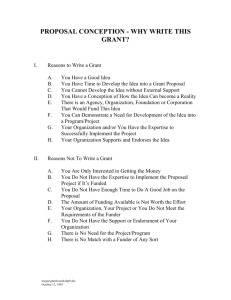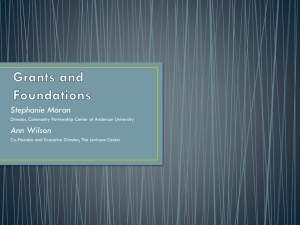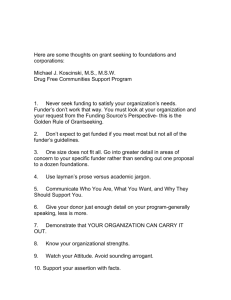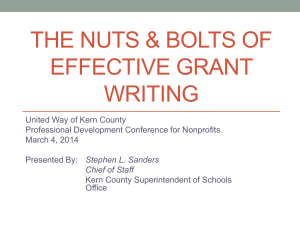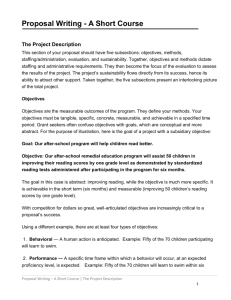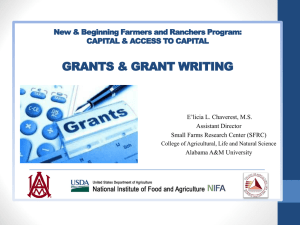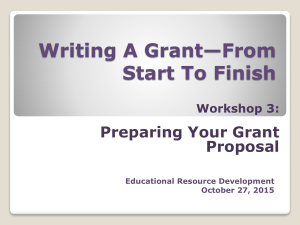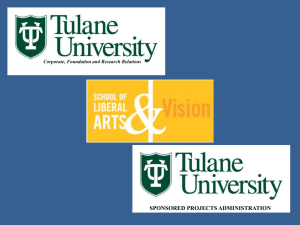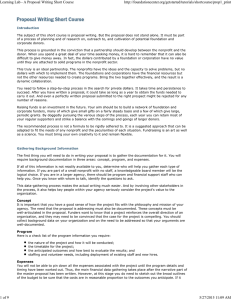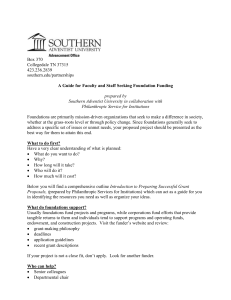Grant Writing Workshop - Sacramento City Unified School District
advertisement
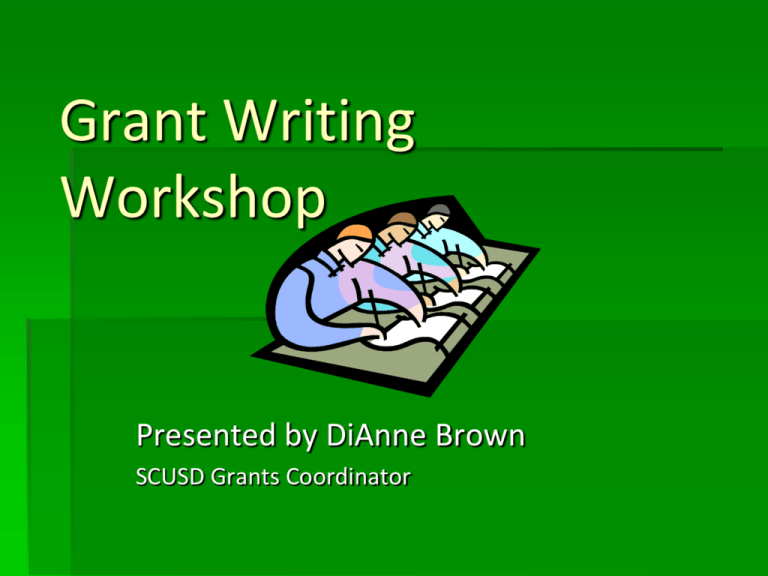
Grant Writing Workshop Presented by DiAnne Brown SCUSD Grants Coordinator Objectives of this workshop: Learn how to put together a winning grant application for a foundation or corporate funding source from start to finish Learn where to find grant funds Learn not to be intimidated by the process! What is a grant? A grant is a monetary award given by a funder What is a grant application? A grant application is a written request asking for money Who gets grant money? Grant money is given to a non-profit organization that has written a winning grant application to a funding source Who provides grant funds? Foundations Corporations Clubs & Organizations County, State & Federal Agencies The Grants process: two scenarios First Scenario You are notified about a funding opportunity that would be perfect for your program or project through an RFA or RFP (Request for Application/Proposal) Second Scenario: You have a program or project that needs funded but a source of funding has not yet been identified. We will focus on this scenario first… Step One: Define Your Project Project Planning 1. Clarify the purpose of your project. 2. What will funding cover? 3. Who is your target audience? 4. Identify potential partners 5. Draft a proposal timeline that includes the planning phase, the period of searching for funds, proposal writing, and the proposal deadline(s). Step Two: Define the Goals and Outcomes of your Project Goal: a statement of general purpose and direction—it is the ultimate end result. example: “The goal of our program is to provide students with the skills they need to become tomorrow’s leaders.” Objective: a statement describing what the project will achieve. Objectives are always measurable and should be SMART: Specific Measurable Attainable/achievable Realistic Time-bound Example: “We will serve 300 students in the 2011-12 school year.” Outcome: the result of program operations or activities or the effects produced by the program. Outcomes may be tied to a specific objective, or may be the cumulative result of objectives. example: “at least 20 students will advance one grade level after participation in the program.” Step Three: Identify the Right Funding Sources Find a Funder who is interested in your project and priorities • Start first with Sacramento area private foundations and corporate funders • Visit the Sacramento Non-Profit Resource Center (www.nprcenter.org) and use the Foundation Center Directory to research foundations • Or subscribe to the Foundation Center: www.fconline.foundationcenter.org Sacramento Funding Sources: California Endowment Foundation, Building Healthy Communities http://sacbhc.org Sierra Health Foundation www.sierrahealth.org Teichert Foundation www.teichert.com Kaiser Permanente Community Benefits Grants Program http://info.kp.org/communitybenefit/html/grantmaking/norther n-california/applications.html Sacramento Metropolitan Arts Commission www.sacmetroarts.org Sacramento Region Community Foundation www.sacregcf.org Funding for schools: www.grantwrangler.com Corporate Funders • • • • • • • • Home Depot Lowes Target Starbucks Whole Foods Nugget Market Kohl’s Check out their websites for funding programs and deadlines Step Four: Review the Proposal Guidelines Guidelines usually tell you about: submission deadlines eligibility proposal format (font size, margins, number of pages, etc.) review timetable budgets funding goals and priorities award levels evaluation process and criteria whom to contact other submission requirements Step Five: Update your Timeline and submit a Grant Overview Form to the school site principal Step Six: Write the Proposal The Narrative Narratives typically must satisfy the following questions: What do we want? What concern will be addressed and why it is important? Who will benefit and how? What specific objectives can be accomplished and how? How will results be measured? How does this funding request relate to the funder’s purpose, objectives, and priorities? Who are we (organization, independent producer) and how do we qualify to meet this need? Parts of the Narrative Statement of Need: The statement of need will enable the reader to learn more about the need for your project. It includes purpose, goals, measurable objectives, and a compelling, logical reason why the proposal should be supported. Specific data regarding your school site or district can be found on the California Department of Education website: www.cde.ca.gov. Parts of the Narrative Approach: The method and process of accomplishing your goals and objectives Explain what you’re going to do and how you’re going to do it Include personnel with names of key staff and consultants, if possible (who is going to do what) Parts of the Narrative Evaluation: Determine the impact on the audience you serve and the measurable outcomes of your grant project. Most sound evaluation plans include both qualitative and quantitative data. Examples: pre-and-post tests, surveys Parts of the Narrative Project Work Plan: Paints a picture of project flow that includes start and end dates, schedule of activities, who is responsible for what, and projected outcomes. The work plan is a “map” of your project or program. Parts of the Narrative Credentials: Information about the applicant that certifies ability to successfully undertake the proposed effort. Typically includes institutional or individual track record and resumes. Explain why you are qualified to do what you are proposing to do. Parts of the Narrative The HOOK: The HOOK aligns the project with the purpose, and goals of the funding source. This helps the funder understand why he should fund your project. Parts of the Narrative Sustainability How will you continue the project or program after the grant period ends? Can you identify additional funding sources? The Budget Budgets are Cost Projections. Funders use these factors to assess budgets: ► Can the job be accomplished with this budget? ► Are costs reasonable for the market - or too high or low? ► Is the budget consistent with proposed activities? ► Is there sufficient budget detail and explanation? Only include in the budget what the funder will fund. Many funders provide mandatory budget forms that must be submitted with the proposal. Always use those! Supporting Materials ► Letters of Support ► Resumes ► Exhibit Tables ► Charts Authorized Signatures ► Authorized signatures (such as the school site principal) are sometimes required. Without these, proposals may be rejected. Be sure to allow yourself time to acquire a needed signature. The district offices requires 10 days for signatures. Specifications ► Tailor proposal writing to specifications found in the guidelines. Include only the number of pages allowed. Observe the format. Submission checklist ► The complete proposal must be submitted on time in the requested format with the requested number of copies and original authorized signatures. Step Seven: Follow-Up Contact the funding source about the status, evaluation, and outcome of your proposal Back to the First scenario: You have a program or project that needs funded but a source of funding has not been identified yet…. After you’ve done your funding search and have identified potential funders, write a Letter of Intent The Letter of Intent – no more than three pages The introduction The organization description The statement of need The methodology Other funding sources The final summary The Introduction Serve as the executive summary Includes the name of your organization The amount needed or requested A description of the project Staff qualifications Brief description of evaluation method Timetable The Organization Description Be concise Focus on the ability of organization to meet the stated need Include a brief history Describe your current programs while demonstrating a direct connection between what you are doing now and what you want to do with the funding The Statement of Need Must convince the reader that there is an important need that can be met by your project Describe your target population and appropriate statistical data in abbreviated form Use several concrete examples The Methodology Present a clear, logical, and achievable solution to the need Briefly describe the project, including major activities, project staff, and desired objectives Other Funding Sources Include a brief sentence or paragraph about other funding sources being approached for support of this project The Final Summary Restates the intent of the project Affirms your readiness to answer further questions Thanks the potential funder for consideration Funding Notification If you were not funded, contact the funder to see why. Ask how you can improve your application and when you can apply again. If you were funded, contact the funder with your thanks. Develop a good relationship! For Additional Help Contact DiAnne Brown, SCUSD Grants Coordinator at 643-9101 or dianne-brown@scusd.edu See sample proposals at: http://www.k12grants.org/samples
